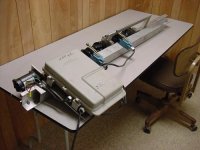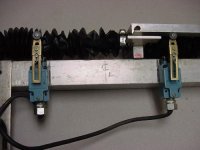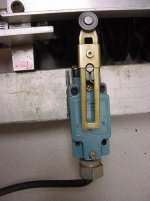You are using an out of date browser. It may not display this or other websites correctly.
You should upgrade or use an alternative browser.
You should upgrade or use an alternative browser.
Moving backer motor
- Thread starter Richard
- Start date
G
Glen Oakes
Guest
Richard
I can't, off the top of my head, tell you the inch-lbs of torque the one used at Tomball has. But, it's pretty significant. Also, ours is geared down pretty heavily so it turns slowly. The actual rpm of any you use is going to depend on the diameter of the take-up pulley. We also have a rheostat for varying rpm and it is set to a value we have determined to be optimum, dependent on the time period of a particular match string.
You might contact Jackie Schmidt. He may have more info on the actual mechanics than I do.
All the best ,
Glen O.
I can't, off the top of my head, tell you the inch-lbs of torque the one used at Tomball has. But, it's pretty significant. Also, ours is geared down pretty heavily so it turns slowly. The actual rpm of any you use is going to depend on the diameter of the take-up pulley. We also have a rheostat for varying rpm and it is set to a value we have determined to be optimum, dependent on the time period of a particular match string.
You might contact Jackie Schmidt. He may have more info on the actual mechanics than I do.
All the best ,
Glen O.
Mike Bryant
Active member
Richard, the best simple backer system I've seen uses a chain with two sprockets mounted horizontally on each end about a foot in length. The gear motor drives one of the sprockets. It has a pulley mounted on the outside of the chain that a cable attaches to run the backer system. It's better than a rotating arm as it doesn't have as much lag time at each end of the travel as the rotating arm. The rotating arm speeds up in the middle and slows down on each end of the travel. If you have a doubled shot it will be more than likely at the end of the travel when it slows down and starts reversing. Anything over 2" per minute of travel will work. When you get too slow such as 1" per minute of travel as used to be common, horizontal groups can give you doubled shots in the backer.
David Halblom
Flying Fish Fundamentals
Mike, would you
David
do a more detailed explanation of your chain/pulley system, please? Your simple explanation intrigues me.Richard, the best simple backer system I've seen uses a chain with two sprockets mounted horizontally on each end about a foot in length. The gear motor drives one of the sprockets. It has a pulley mounted on the outside of the chain that a cable attaches to run the backer system. It's better than a rotating arm as it doesn't have as much lag time at each end of the travel as the rotating arm. The rotating arm speeds up in the middle and slows down on each end of the travel. If you have a doubled shot it will be more than likely at the end of the travel when it slows down and starts reversing. Anything over 2" per minute of travel will work. When you get too slow such as 1" per minute of travel as used to be common, horizontal groups can give you doubled shots in the backer.
David
Gary Walters
New member
Denton, Texas Backer Motor Set-up
Mike's description sounds like Denton's Backer Motor?

Mike's description sounds like Denton's Backer Motor?

David Halblom
Flying Fish Fundamentals
That is a really graphic
explanation of what I visualized. IT WORKS FOR ME
explanation of what I visualized. IT WORKS FOR ME
Mike's description sounds like Denton's Backer Motor?

Boyd Allen
Active member
Last edited:
Mike Bryant
Active member
That's what I was describing. As they say a photo is worth a 1000 words. That's the simplest backer system I've seen and it works very well.
Boyd Allen
Active member
In case someone overlooked it because of the pictures, at the top of my post is a link to a document that gives detailed information about the backer system, including motor specifications.
We use the Stiller design at Brock's Gap and it works well. One question...at River Bend they used a special master link on the chain which provides a good point for attaching the cable endpoint. At Brock's Gap we welded a nut to the master link. I think the River Bend method is better but don't know the Grainger part number or even a description of that special master link. Does anyone know what I'm talking about and could someone provide a part number or description? Sorry...don't have a picture of the River Bend setup.
Dusty Stevens
Hollow Point Dispenser
http://www.grainger.com/product/TSUBAKI-Connecting-Roller-Chain-Link-1YKJ2
you looking for something like this steve? check with conveyor parts thats how they attach stuff to conveyor chains and theres millions of em.
you looking for something like this steve? check with conveyor parts thats how they attach stuff to conveyor chains and theres millions of em.
When I set up one of the systems using Jerry Stillers plans I used a 12v DC gear motor to drive it (no power at the range) and used a double chain joiner link and drilled a piece of steel so that the joiner link would fit it, then removed the outer link of the joiner and welded the piece of steel on the two pins then mounted a rotating pulley for the cable to attach to.
I'll try to remember to take a photo and post it..........Ian
I'll try to remember to take a photo and post it..........Ian








